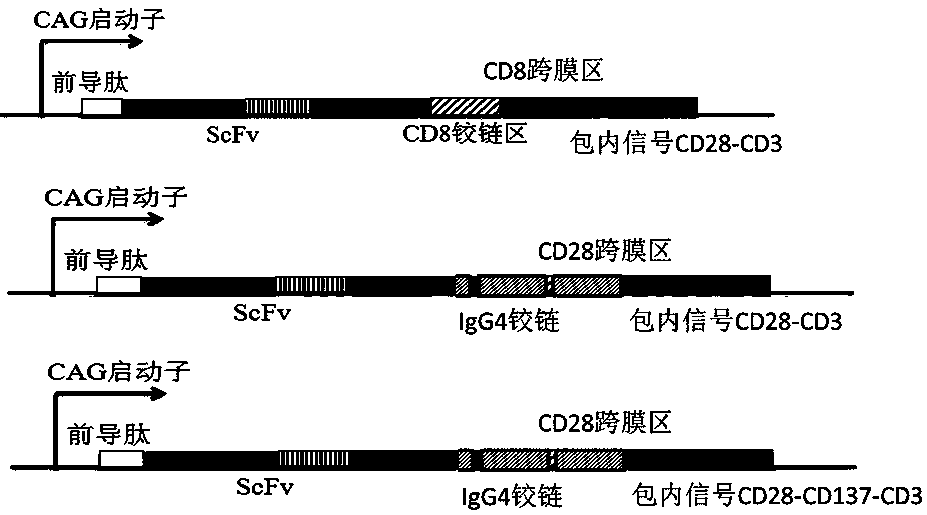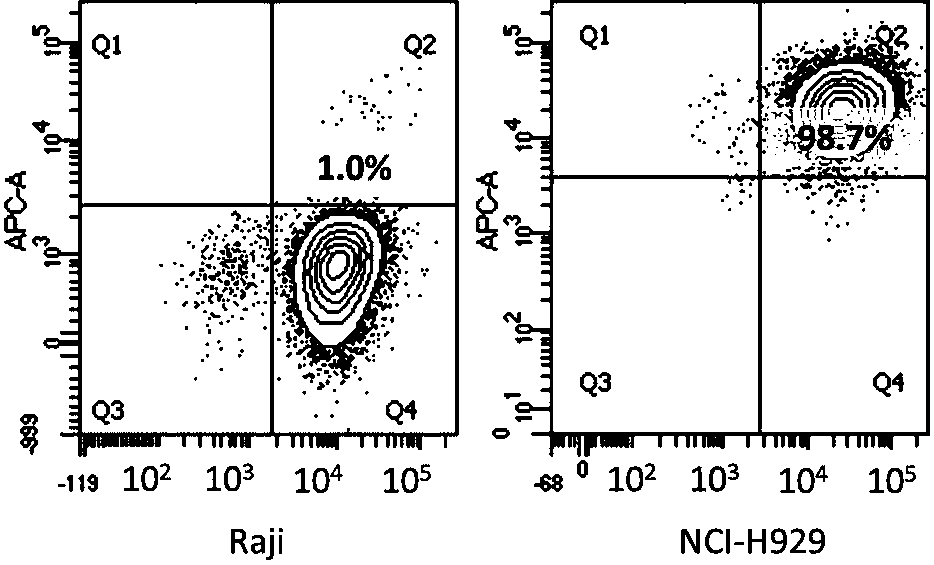Anti-BCMA antigen chimeric antigen receptor and application thereof
A chimeric antigen receptor and antigen recognition technology, applied in the field of genetic engineering, can solve the problems of tumor cells off-target, unable to solve the survival crisis of MM patients, and unable to cure them
- Summary
- Abstract
- Description
- Claims
- Application Information
AI Technical Summary
Problems solved by technology
Method used
Image
Examples
Embodiment 1
[0063] Example 1 Construction of chimeric antigen receptor virus containing BCMA scFv
[0064] In order to construct a more effective chimeric antigen receptor against BCMA, we used 8 antibody strains to construct its scFV and designed BCMA(1), BCMA(2), BCMA(3), BCMA(4), BCMA(5), BCMA( 6), BCMA(7), BCMA(8), BCMA(9) and BCMA(10) have a total of ten groups of CARs, including 3 structures such as figure 1 shown.
[0065] 1 Synthesis of gene sequences of chimeric antigen receptors targeting BCMA containing different scFvs
[0066] Synthesize different single-chain antibody ScFv containing anti-human BCMA antigen, IgG4 or human CD8 hinge region (also known as hinge region), CD28 transmembrane region (abbreviated as TM), CD28 and / or CD137 and CD3 co-stimulatory signal combination The resulting chimeric antigen receptor has a structure such as figure 1 As shown, from left to right are marker, original plasmid and restriction plasmid.
[0067] 2 Construction of lentiviral vectors ...
Embodiment 2
[0082] Example 2 Expression of BCMA in different tumor cells
[0083] The tumor cells Raji and NCI-H929 cultured for 10 days were collected into 10ml centrifuge tubes respectively, and the expression of BCMA was detected by flow cytometry using APC-BCMA antibody (BD Company).
[0084] The result is as image 3 As shown, NCI-H929 is a high-expression BCMA cell, and Raji is a BCMA-negative cell.
Embodiment 3
[0085] Example 3 Detection of CAR Transfection T Cell Ability and CAR-T Cell Killing Ability
[0086] 1. Detection of the ability of BCMA-CAR to transfect T lymphocytes
[0087] 1 Isolation of human peripheral blood mononuclear cells
[0088] Human peripheral blood mononuclear cells were separated by gradient centrifugation to obtain PBMC cells, which were cultured by adding RPMI1640 complete medium containing 10% FBS.
[0089] 2 Lentiviral vector infection of T lymphocytes
[0090] Mononuclear cell PBMCs obtained in step 1 were activated by adding anti-CD3 monoclonal antibody on the first day; lentivirus infection was carried out in the first 3 days; lentiviral vector corresponding to 5MOI was added, and uninfected T lymphocytes were used as blank control; after 24 hours, culture The base was replaced with RPMI 1640 complete medium containing 500 IU / ml recombinant human IL-2, and the culture was continued for 10-20 days.
[0091] During the culture process, the virus-infec...
PUM
 Login to View More
Login to View More Abstract
Description
Claims
Application Information
 Login to View More
Login to View More - R&D
- Intellectual Property
- Life Sciences
- Materials
- Tech Scout
- Unparalleled Data Quality
- Higher Quality Content
- 60% Fewer Hallucinations
Browse by: Latest US Patents, China's latest patents, Technical Efficacy Thesaurus, Application Domain, Technology Topic, Popular Technical Reports.
© 2025 PatSnap. All rights reserved.Legal|Privacy policy|Modern Slavery Act Transparency Statement|Sitemap|About US| Contact US: help@patsnap.com



